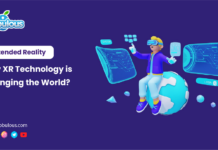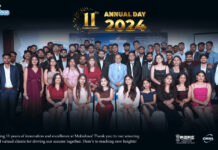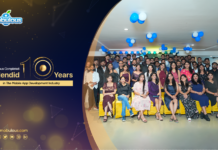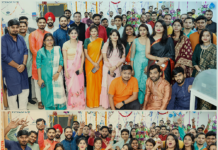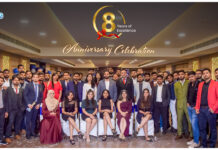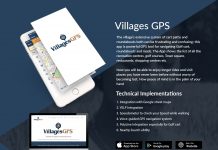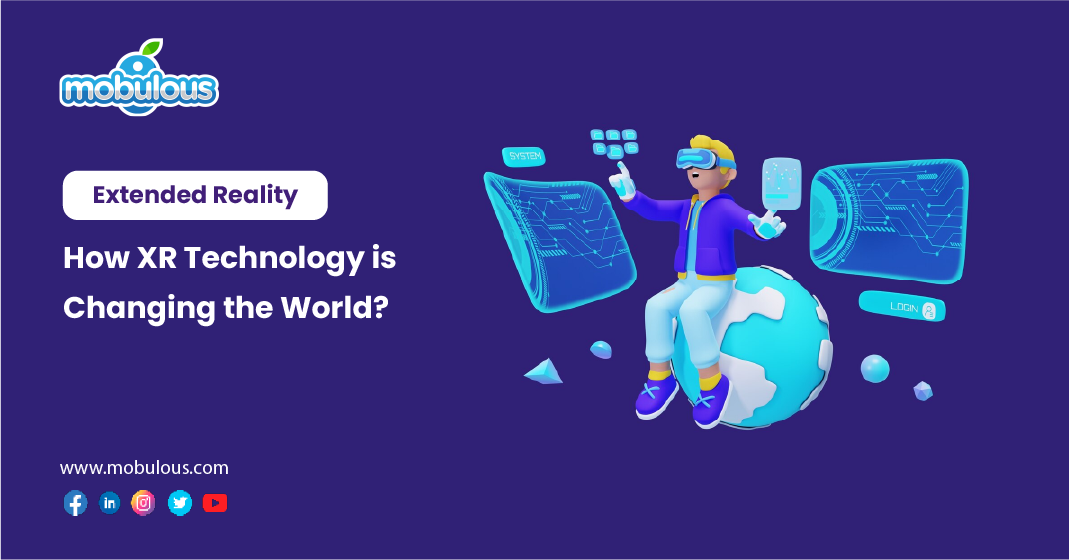Extended Reality: How XR Technology is Changing the World?
Extended reality (XR) is an umbrella term that encompasses various merged real and virtual world experiences, including Augmented reality (AR), Virtual reality (VR), and Mixed reality (MR).
Since 2024 ended, advances in XR technology have dramatically transformed how we live our lives and opened up numerous industries to new opportunities.
As we’re moving forward, XR has the potential to revolutionize computer-generated environments like never before and change the way we react to the physical world. This will further enrich the productivity, communication, and overall user experience.
For Query:- Seek Guidance From a Mobile App Development Company!
What is Extended Reality?
Extended reality technology encompasses Augmented, Virtual, and Mixed realities all under the same umbrella term.
Immersive tech uses immersive visuals and sound to combine the physical world with its digital counterpart, providing users with an intuitive experience while immersed in either an augmented or virtual environment.
By using visual data acquisition that is addressed either locally or shared, XR reality transfers it over a network and to the human senses.
The domain of AR and VR is growing at a rapid pace and is applied in various industries such as gaming, healthcare, real estate, etc. This XR extended reality tech is used for joint effort in the offices, education purposes, training, treatment, information discovery and analysis, etc.
For Query:- Seek Guidance From an AR/VR App Development Company!
Types of XR Experiences in Real-World
Extended reality was highlighted when AR/VR (Augmented Reality and Virtual Reality) started to be used by developers in IT and tech companies across the world.
Not only this, but also XR technology has been used in various movies, but using it in the reel world is extremely different when compared with the real world.
But to understand this perfectly, we need to learn the top technologies that are used to make XR, including Augmented reality (AR), Virtual reality (VR), and Mixed reality (MR).
1. Augmented Reality
When virtual objects and imaginations are put up into the real world, augmented reality or AR comes into the picture. This technology doesn’t put us into a virtual world or computer-gen graphics but creates a sense of illusion in digital gadgets.
Still, the users have access to the real world and they are able to interact in both dimensions consistently. In this domain, the most popular example is ‘The Pokemon Go app’ which uses AR in its app development to help users interact with both real and virtual worlds with the help of digital gadgets.
Also Read:- How can Augmented Reality (AR) help to boost your business?
2. Virtual Reality
When talking about virtual reality (VR), the users are put into a virtual environment where they interact in the virtual world only. The graphics that are generated are mostly artificial objects and computer-based which provides users with a real feeling.
In addition to this, there are various special VR devices that put users into environments that give them a view of a 360-degree virtual world.
Few apps offer virtual reality experiences to users where they can feel what looks best for their homes, looks, and offices through their cameras, including Lenskart, Ikea, etc.
3. Mixed Reality
The combination of both AR and VR, i.e., Augmented reality and Virtual reality is what is termed as Mixed reality (MR). Here, users can interact with both the real and digital world simultaneously.
Through special MR devices, these users can visualize their surroundings efficiently. Not only are these MR devices are robust than VR devices but they are costly too.
For instance, putting on an MR device can help you do whatever you want, watch your surroundings, close the windows, throw a ball, digitally. However, these won’t be happening in reality and everything will remain as they are.
The Benefits of Using XR Technology in Business
XR tech enhances customer engagement, personalizes experiences, provides better collaboration, and training opportunities, increases sales, enhances knowledge retention, etc. Let’s understand them in detail:
1. Enhanced Customer Engagement
Extended reality allows businesses to create engaging product demonstrations and interesting experiences that appeal to customers.
Through AR product visualizations and virtual showrooms, customers can analyze items comprehensively before purchasing.
XR reality can bridge the gap between physical and online shopping experiences, creating enhanced user engagement and longer engagement periods with brands.
2. Personalized Experiences
XR reality enables businesses and firms to customize experiences to individual customer preferences and needs.
Through AI/ML integration and data collection, firms are able to develop tailored virtual environments and product recommendations.
Customers can visualize products at their own convenience, adjust features in real time, and receive personalized guidance. This makes their journey more meaningful and relevant.
3. Better Collaboration
Virtual reality and augmented reality platforms enable teams to collaborate seamlessly across geographical borders.
Remote and hybrid employees can join virtual meetings, collaborate on shared projects, and interact with 3D models in real-time.
This technology breaks down distance barriers, promotes more effective communication, and lowers travel costs through immersive shared spaces.
4. Training Opportunities
XR reality provides safe and cost-efficient training environments where employees can safely practice complex scenarios and procedures without risk to themselves or the organization.
Simulation allows employees to gain hands-on experience, from manufacturing processes to customer service scenarios.
This approach to training reduces costs, ensures consistent quality across locations, and accelerates skill development smoothly and effortlessly.
5. Increased Sales
XR technology enables customers to virtually try the products that they want to buy before even purchasing them through digital gadgets, significantly reducing purchase uncertainty and returns.
Not only this, customers can also visualize furniture in their homes, thus boosting confidence in buying. This leads to higher conversion rates and increased customer satisfaction.
6. Enhanced Knowledge Retention
XR reality’s immersive nature develops stronger memory imprints compared to traditional learning methods. Through interactive 3D visualizations and hands-on virtual experiences, employees retain information better and longer.
This technology facilitates experiential learning by making complex topics more comprehensible and memorable through practical applications in virtual reality environments.
Emerging Trends in Extended Reality (XR)
Existing trends in virtual reality (XR), including AI-powered XR experiences, enterprise adoption of VR/AR solutions, 5G-enabled mobility for VR applications, and mixed reality commerce platforms as well as social XR platforms are constantly emerging. Let’s comprehensively learn them:
1. AI-Powered XR Experiences
The integration of Artificial intelligence with extended reality is revolutionizing interactive experiences. AI provides more natural interactions through gesture recognition, contextual awareness, and eye tracking.
Machine learning algorithms are improving real-time object recognition, environment mapping, and personalized content delivery. This convergence is creating more responsive and intuitive XR apps across training, gaming, and medicinal apps.
For Query:- Seek Guidance From an AI/ML App Development Company!
2. Enterprise XR Adoption
Firms and businesses are enforcing XR solutions for remote collaboration, product design, and training at a rapid pace. Virtual Meeting spaces enable developers to interact with data visualizations and 3D models in shared environments.
Industries like healthcare, architecture, and manufacturing are using XR technologies for advanced surgical planning, complex task training, and architectural visualization that drive significant enhancements in cost reduction and efficiency.
Also Read:- Enterprise Mobile App Development Trends (IoT, Blockchain, 5G)!
3. 5G-Enabled XR Mobility
Do you know what is transforming XR capabilities?
Yes, 5G networks have significantly advanced extended reality capabilities by offering low-latency experiences and increased bandwidth on mobile devices.
This infrastructure allows cloud-rendered XR content to be displayed locally without needing expensive hardware. Mobile XR technologies now deliver more advanced visuals and real-time interactions that make immersive experiences more portable and accessible.
4. Mixed Reality Commerce
Retailers are turning to XR technology in order to provide their customers with enhanced shopping experiences that allow them to virtually test products prior to making purchases.
Modern AR applications allow virtual clothing try-ons, realistic furniture placement simulations, and interactive product demos – providing shoppers with an interactive shopping experience and creating enhanced purchasing decisions.
This innovative trend is revolutionizing e-commerce and retail industries by decreasing return rates, building customer trust, and creating more enjoyable shopping experiences for everyone out there.
5. Social XR Platforms
Virtual social spaces are evolving into complex ecosystems that support genuine social commerce and interaction.
These platforms combine realistic avatars, spatial audio, and shared experiences into virtual environments that enable users to attend virtual events, take part in immersive social activities, collaborate on projects, and form new forms of digital entertainment and community.
The Challenges of Extended Reality & Its Solutions
Although XR technology is revolutionary, it faces various significant hurdles that need to be addressed for widespread adoption, such as hardware limitations, motion sickness, privacy/security risks, content development costs, and accessibility concerns. All these issues need to be overcome to ensure widespread acceptance of this revolutionary technology.
| Challenge | Description | Solution |
| Hardware Limitations | Current XR devices suffer from limited field of view, bulky form factors, and short battery life, impacting user comfort and prolonged usage scenarios. | Development of lightweight materials, advanced optics, and energy-efficient processors, alongside investment in better battery technology and miniaturization of components. |
| Motion Sickness | Users often experience nausea and disorientation due to sensory conflicts between visual inputs and physical movement, particularly during extended use of VR headsets. | Implementation of advanced motion tracking reduced latency, and adaptive refresh rates, plus designing experiences that minimize sudden movements and provide visual anchors. |
| Privacy & Security | XR systems collect vast amounts of sensitive data, including biometric information, spatial mapping, and user behavior patterns, raising concerns about data protection. | Integration of robust encryption protocols, secure data storage solutions, and transparent privacy policies, combined with user control over data collection and sharing. |
| Content Development | Creating high-quality XR content requires specialized skills, expensive tools, and significant time investment, limiting the availability of engaging applications. | Development of user-friendly creation tools, standardized development platforms, and shared content libraries, plus investment in training programs for XR content creators. |
| Cost & Accessibility | High prices of XR devices and development tools create barriers to entry for both consumers and developers, limiting market growth. | Introduction of more affordable hardware options, cloud-based development platforms, and subscription models for content access and development tools. |
Key Hardware in Extended Reality
XR depends highly on advanced hardware components in order to deliver high-end experiences. Every hardware technology, including headsets, Meta Quest 3, and smartglasses, plays a vital role in creating smooth interactions between physical and virtual environments.
1. Headsets
Extended reality headsets play an indispensable role in providing immersive experiences, enabling users to navigate virtual spaces and access digital media content.
There are various headsets designed to create the XR reality experience, from Virtual Reality (VR) headsets to Augmented and Mixed Reality models.
Oculus Rift and HTC Vive virtual reality headsets encase users’ faces while completely isolating them from their surroundings, creating a 360-degree intuitive experience requiring special cameras or sensors in order to track the movement of users.
Microsoft HoloLens AR headsets enable users to experience online content superimposed onto the real-world view of users, giving access to virtual information or objects while staying aware of their surroundings.
2. Meta Quest 3
Onirix fully integrates with Meta Quest 3 virtual reality headset technology for an interactive and engaging virtual reality experience for its users.
Meta Quest 3’s virtual reality glasses are specifically tailored to wrap around and envelope their user, blocking out distractions in real life and immersing them into an engaging 360-degree virtual environment.
This device utilizes sophisticated sensors and cameras designed to track user movements precisely for more realistic virtual experiences.
3. Smartglasses
Smartglasses are another groundbreaking piece of XR hardware, usually appearing like regular eyewear but equipped with cameras, sensors, and displays for seamless access to AR apps and information.
Smart glasses such as Google Glass tend to be used for enterprise development applications, while others, like Nreal Light, offer AR experiences directly to consumers.
Extended reality technologies depend heavily on smart glasses and headsets that give users interactive content, combining digital with real-world elements.
As technology quickly develops, we can anticipate significant advancements to these essential hardware elements that enhance XR apps further.
How Cloud and 5G Empower Extended Reality
Cloud and 5g helped make extended reality a business success nowadays. It empowers XR reality by providing the required high-speed connectivity and processing power in order to deliver immersive and seamless experiences.
Their potential to handle large data volumes with minimal latency has enabled real-time interactions within virtual environments. It makes XR apps more accessible and highly applicable across multiple industries and business niches.
Cloud technology enables XR tech content to be stored and accessed remotely. Due to this, users don’t need to have robust devices in order to run XR apps. Instead, users can access the content from any device, and what they need is just a good internet connection.
For Query:- Seek Help From a Cloud Hosting Services Company!
Digital Twins and Extended Reality
Digital Twins or “Digital Twins,” and Extended Reality, or “XRs” are closely interlinked. Digital Twins (DTs) are virtual representations of physical objects, systems or processes that mimic real-world behavior in real-time whereas Extended Reality encompasses Virtual Reality (VR), Augmented Reality (AR), and Mixed Reality (MR) which all provide immersive digital experiences.
Integration of this technology enables users to interact with digital TDs using immersive interfaces for maximum control and visualization.
Manufacturers leverage virtual reality (XR) technology to interact with virtual replicas of their production lines; architects use VR to guide clients through virtual buildings before starting construction; this combination revolutionizes how we design, monitor, and optimize real-world systems.
Extended Reality in Different Industries
XR technology is transforming multiple industries by offering immersive and interactive experiences that improve productivity, user engagement, and training. Let’s understand how extended reality is making an impact across different industries such as gaming, healthcare, education, real estate, retail, etc.
1. E-Commerce & Retail
Retailers use extended reality for virtual try-ons and engaging shopping experiences. Augmented reality applications allow customers to visualize furniture in their homes or try on clothes digitally.
Virtual reality showrooms provide personalized shopping experiences, whereas digital product visualization helps customers make informed decisions without the requirement of specific physical samples.
For Query:- Seek Assistance From an E-commerce App Development Company!
2. Healthcare
Doctors and other medical professionals leverage extended reality for patient education, surgical planning, and medical training. Surgeons practice difficult procedures in Virtual reality, whereas augmented reality helps in real-time during operations.
Medical students learn anatomy through immersive 3D models, and therapy patients undergo treatment by using VR for situations like phobias and PTSD.
For Query:- Seek Assistance From a Healthcare App Development Company!
3. Education
XR tech transforms traditional learning into interactive experiences. Both students and teachers explore historical sites through CR field trips, visualize advanced concepts in 3D, and conduct virtual science experiments.
Augmented reality applications improve textbooks with engaging content, whereas collaborative virtual reality environments allow remote learning and cross-cultural educational experiences.
For Query:- Seek Assistance From an Education App Development Company!
4. Real Estate
XR technology revolutionizes property visualization and marketing. Potential buyers take virtual tours of properties on a global scale, whereas augmented reality apps display property information in real time.
Architects and designers leverage virtual reality in order to display unbuilt properties and modifications, enabling clients in order to experience spaces before the real construction gets started.
For Query:- Seek Assistance From a Real Estate App Development Company!
5. Gaming
Gaming leads XR innovation with VR headsets and AR mobile games. Titles like Half-Life: Alyx and Pokémon GO demonstrate immersive storytelling and blended reality experiences.
The industry persists in driving boundaries with palpable feedback, eye-tracking, and social VR platforms, developing more engaging and realistic gaming experiences for players on a global scale.
The Future of Extended Reality
The near future of XR technology is highly promising, with advancements in technology, and hardware that make it more accessible and immersive. XR symbolizes a fusion of various technologies that incorporate the virtual and physical worlds.
It encompasses all three high-tech technologies, including Augmented Reality (AR), Virtual Reality (VR), and Mixed Reality (MR) that have the potential to transform our interactions with the digital domain.
The market of XR technology is expected to rise rapidly in the upcoming years. We can say this because of the following points:
- In 2022, the XR market was valued at around USD 37.9 billion.
- By 2025, the XR market is expected to reach USD 87.3 billion.
- By 2030, the XR market is expected to reach USD 294.6 billion.
- By 2032, the XR market is expected to reach USD 519.5 billion.
This growth has been calculated after considering the below XR growth factors:
- Increasing consumer awareness and acceptance of XR technologies.
- Growing use of XR in education, healthcare, gaming, and other industrial sectors.
- Integration of spatial computing into XR applications.
- Expansion of generative AI and Ambient Intelligence in XR applications.
- Integration of XR with smart devices, e-commerce, and retail.
- Expanding XR content libraries.
- XR in cultural heritage preservation.
Extended reality will transform how people live their day-to-day lives and revolutionize their perception of reality. Not only this, but it will also strengthen the bonds within workplaces and communities.
How to Get Started with Extended Reality?
Begin by identifying your specific needs and selecting the most suitable XR technology (VR, AR, or MR). Start with entry-level hardware like smartphone-based AR or affordable VR headsets.
Explore different development platforms like Unity or Unreal Engine for creating content. Join online communities and take courses in XR development. Start with simple projects and gradually build complexity as you gain experience with the technology.
Final Talk
XR tech encompasses all three types of realities, i.e., augmented, virtual, and mixed, hence it is considered an umbrella term for these realities. Augmented, virtual, and extended reality has been the talk of the year since 2025 began.
It’s not too far when XR technology will become the most profitable technology for businesses it will surely assist them in enhancing their productivity and achieving their business goals seamlessly.
FAQs- Extended Reality: How XR Technology is Changing the World?
Q. Who invented Extended Reality?
Ans. XR reality was not invented by a single person but it evolved from different technologies and innovations. Morton Heilig’s Sensorama (1957) is considered an early milestone, whereas Ivan Sutherland’s work in the 1960s laid essential foundations for XR tech development.
Q. What do you mean by extended reality?
Ans. Extended reality or XR is considered an umbrella term that encompasses all real and virtual blended worlds and human-machine interactions. It includes Augmented Reality (AR), Virtual Reality (VR), and Mixed Reality (MR) to represent the spectrum of blended virtual and real environments.
Q. What is the difference between VR AR and XR?
Ans. VR or Virtual Reality creates fully intuitive digital environments, AR or Augmented Reality overlays online content onto the real world, whereas XR encloses both plus Mixed Reality. XR is the more comprehensive variety that includes all virtual-real spectrum technologies and interactions.
Q. Who uses extended reality?
Ans. Extended Reality is used across diverse industries including healthcare for surgical training, education for immersive learning, manufacturing for design and assembly, entertainment for gaming, military for combat simulation, retail for virtual shopping experiences, etc.
Q. How is XR used?
Ans. XR tech is used through specialized hardware like headsets, smart glasses, and mobile devices. Users can interact with virtual objects, experience immersive environments, receive real-time information overlays, and engage in remote collaboration or training scenarios.









